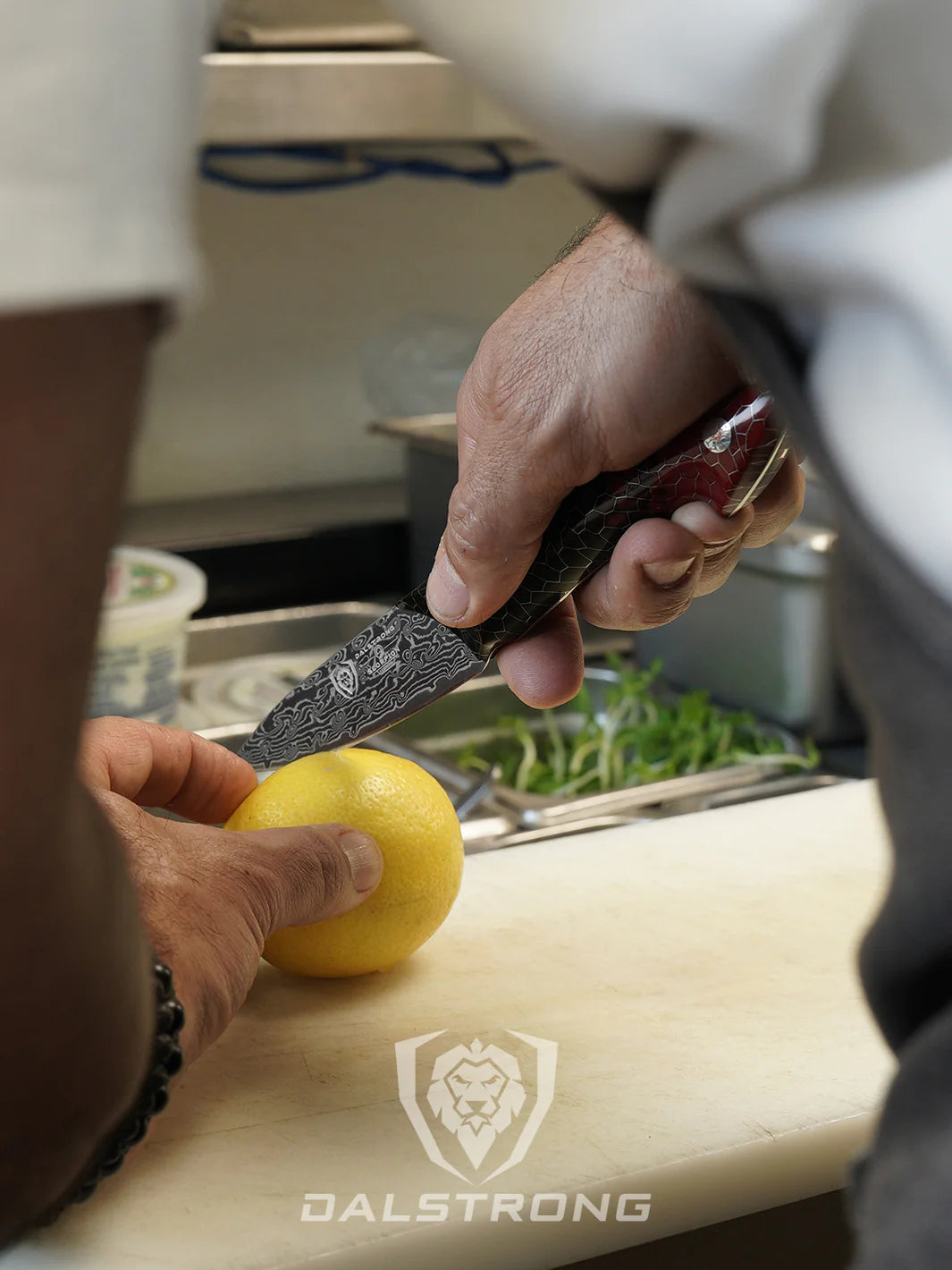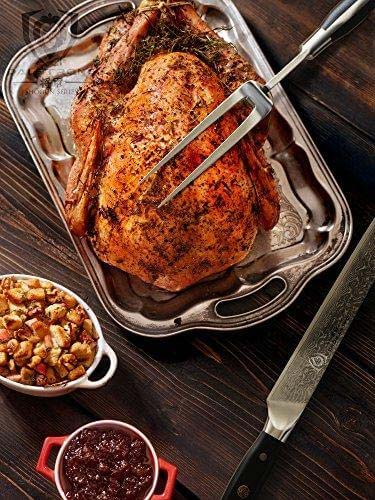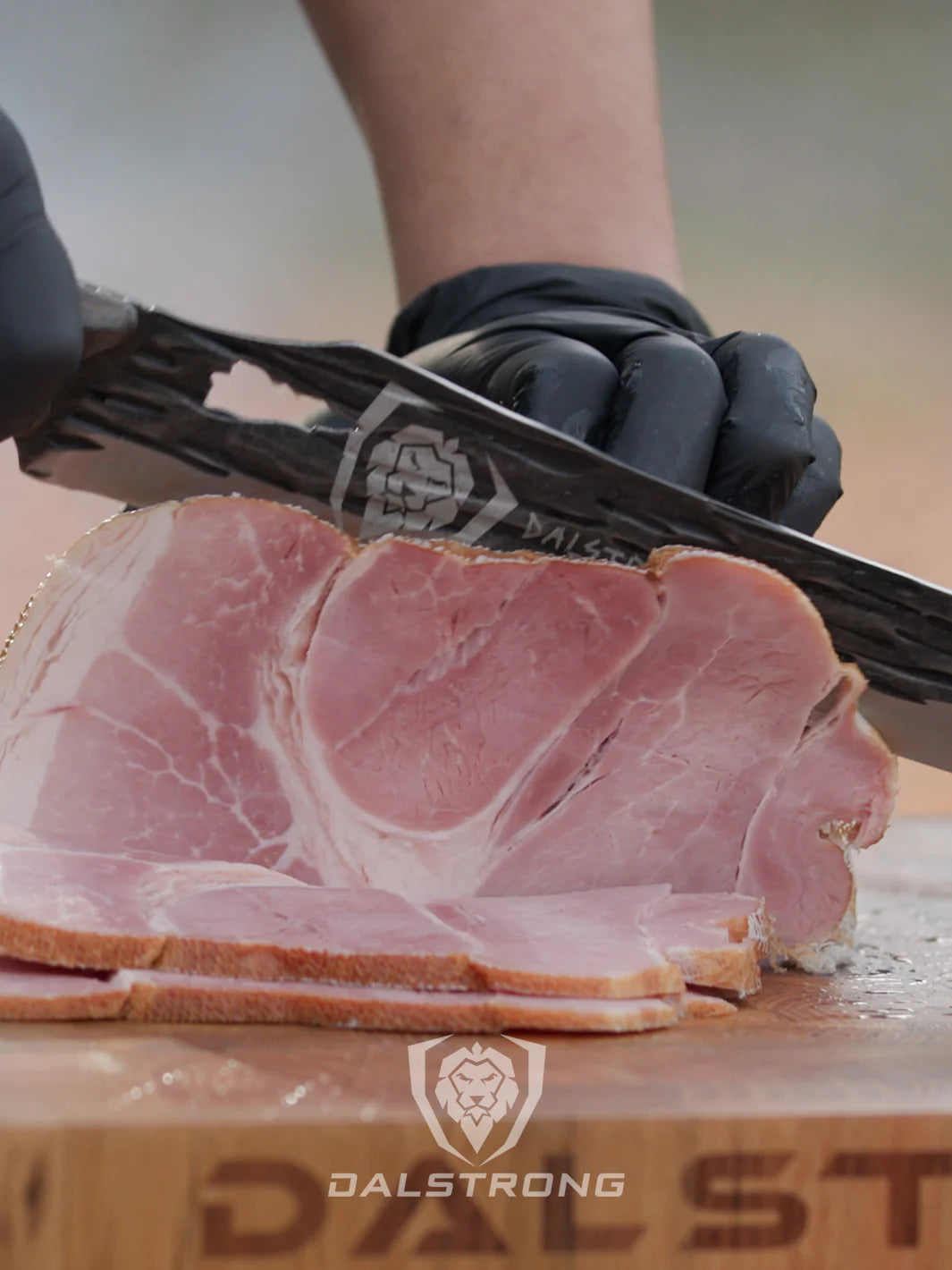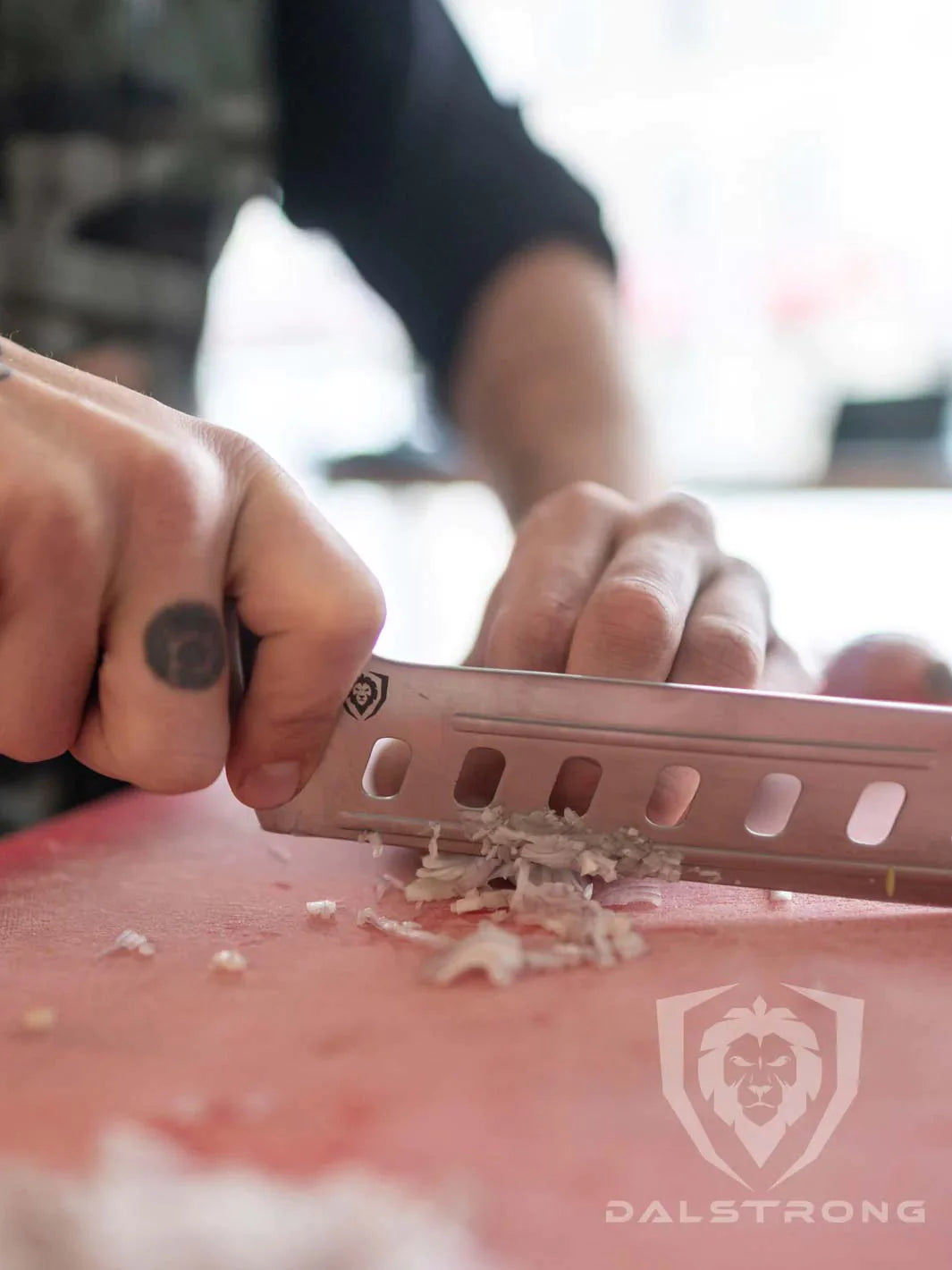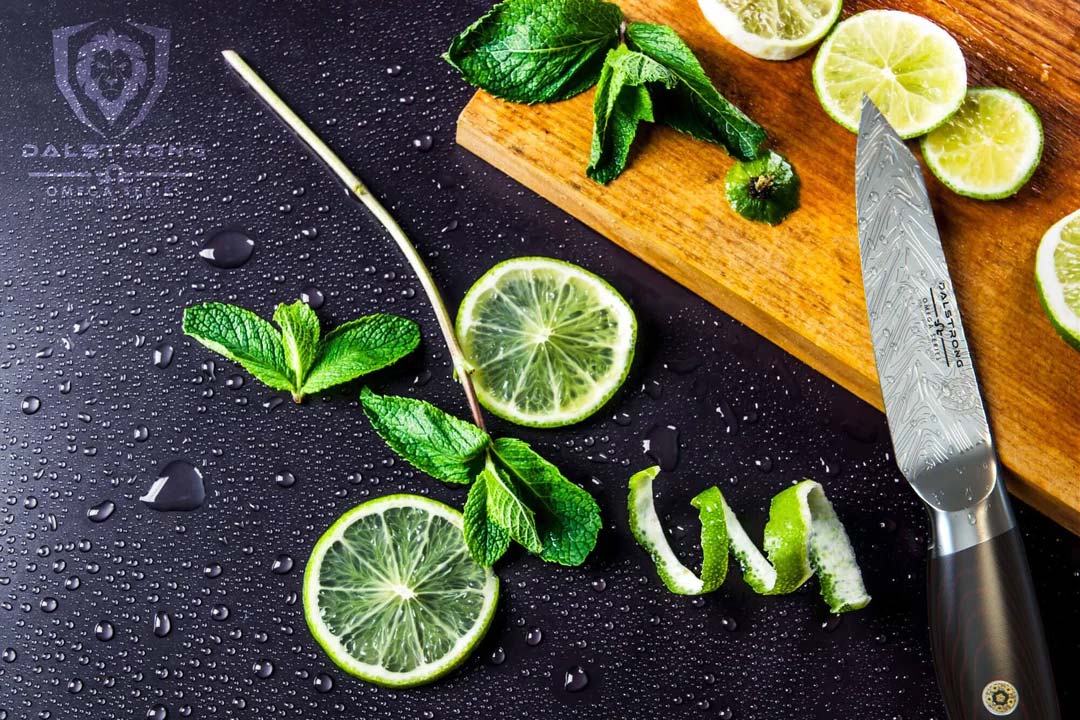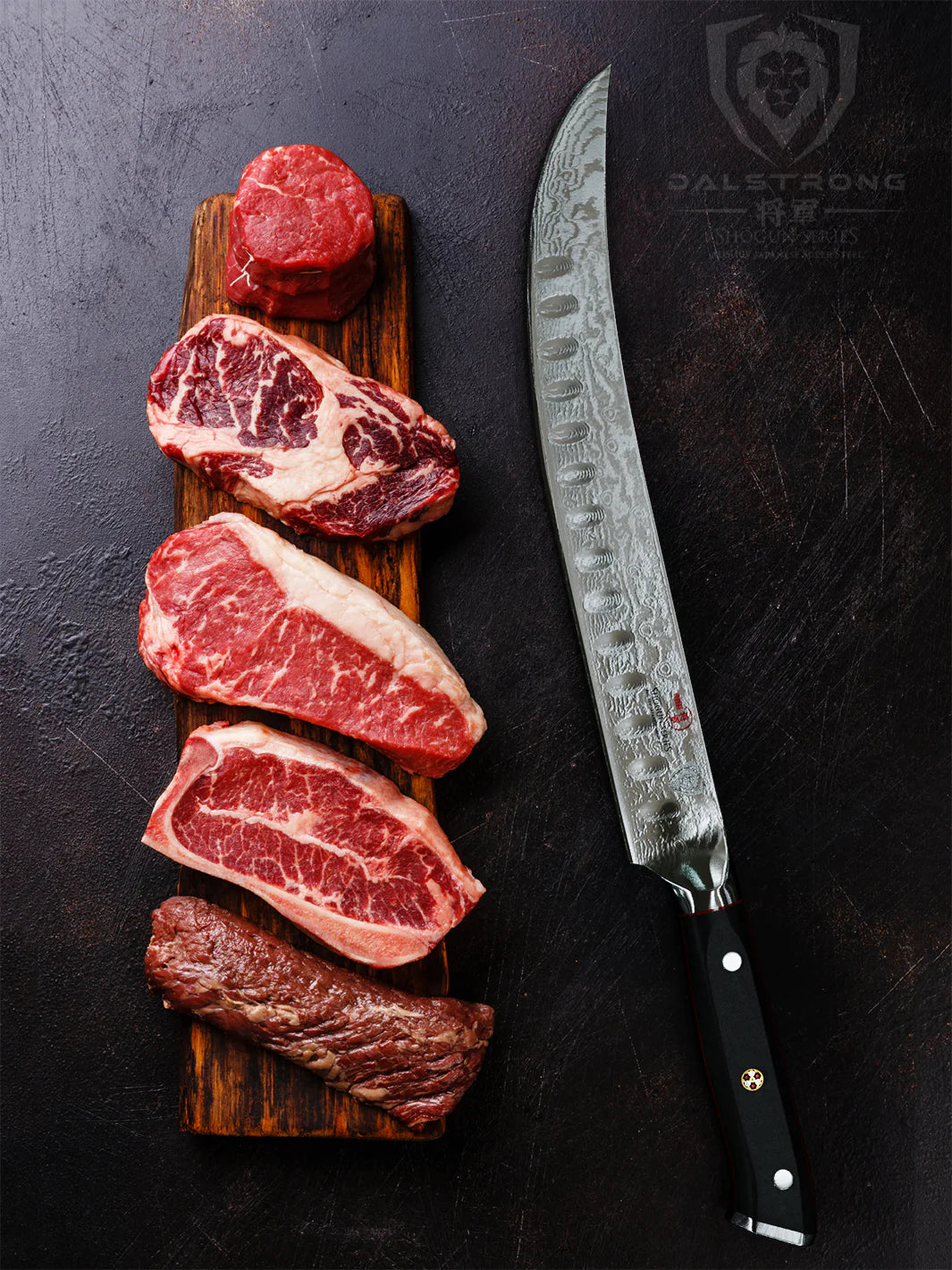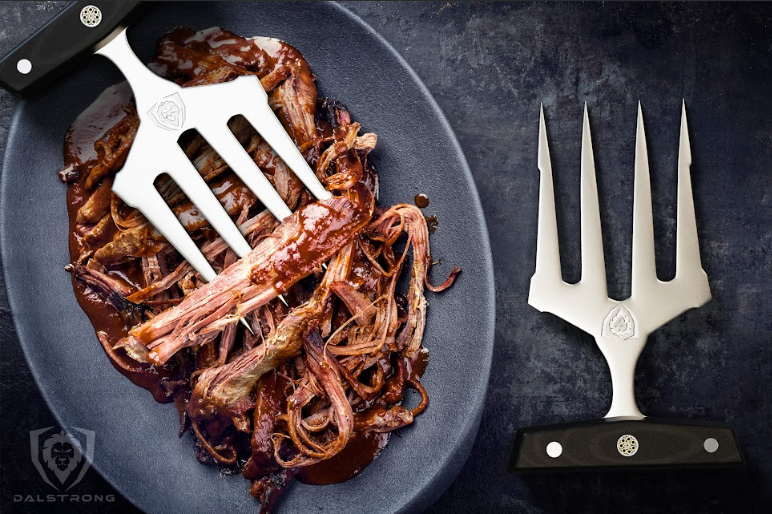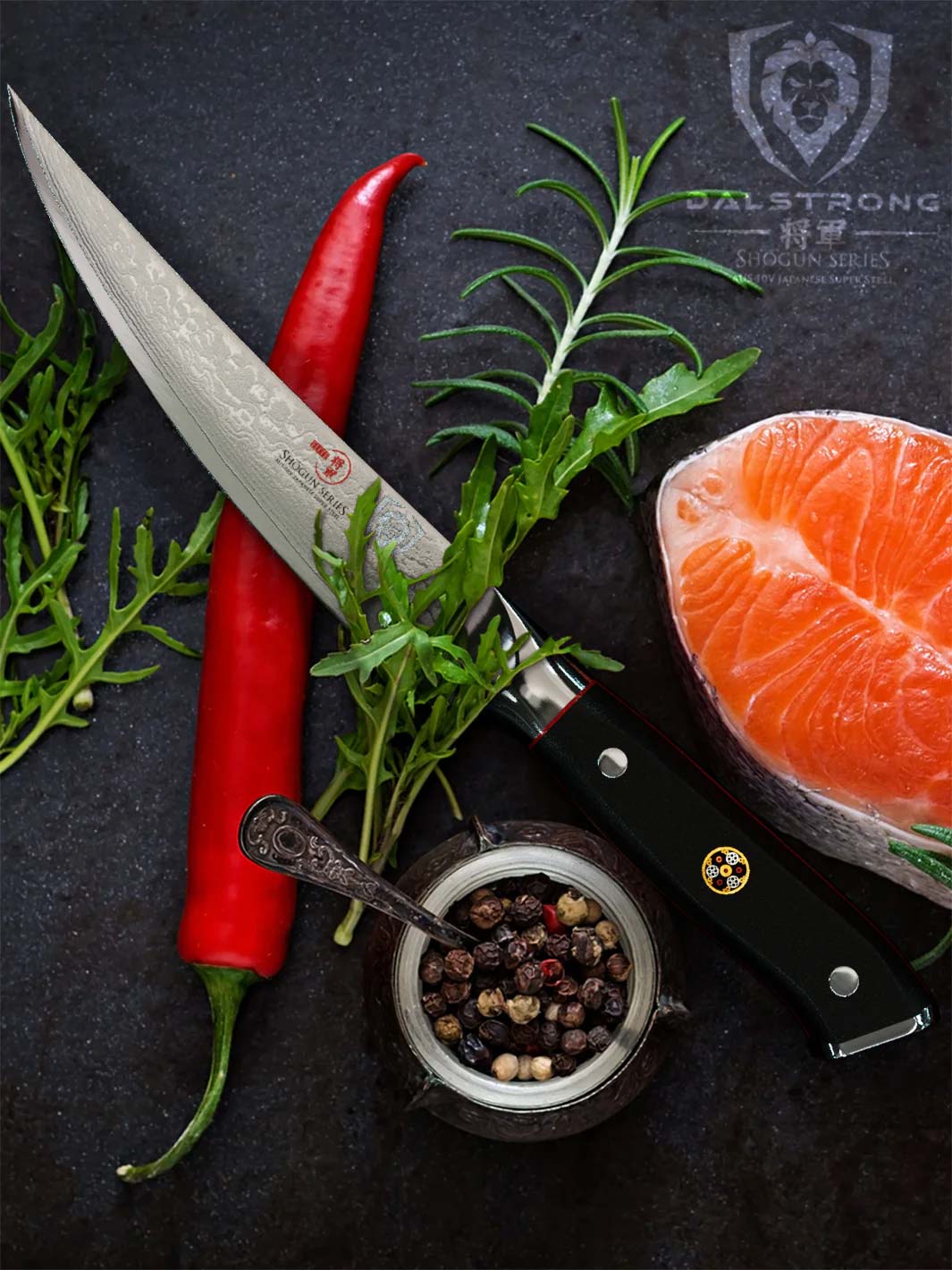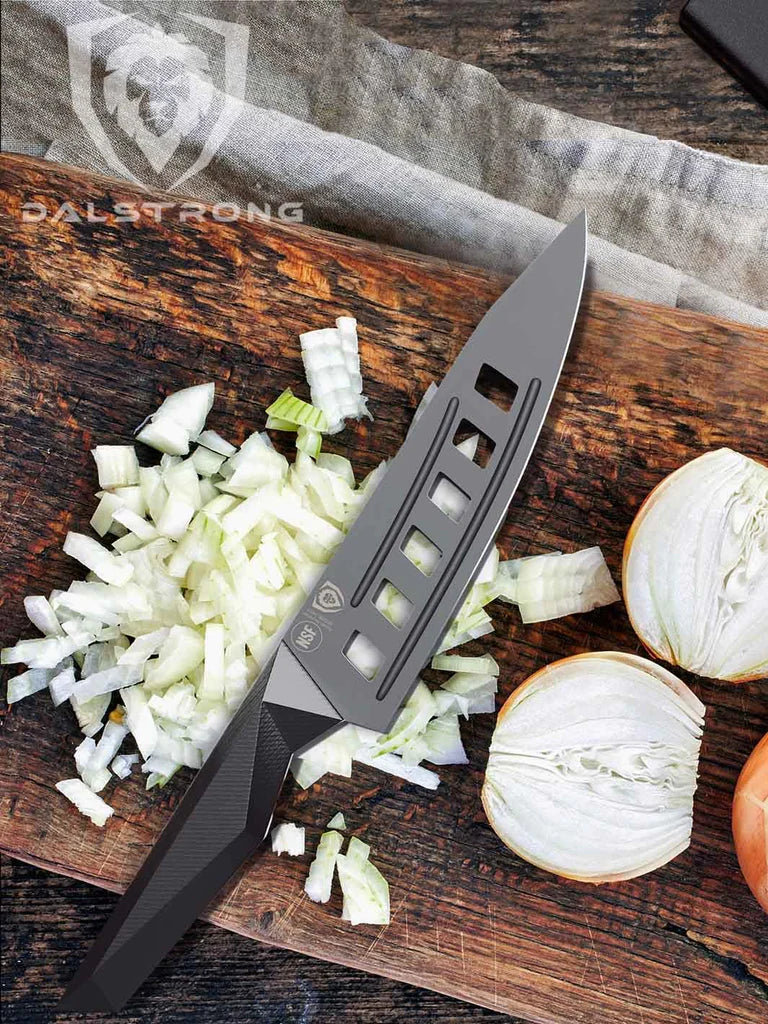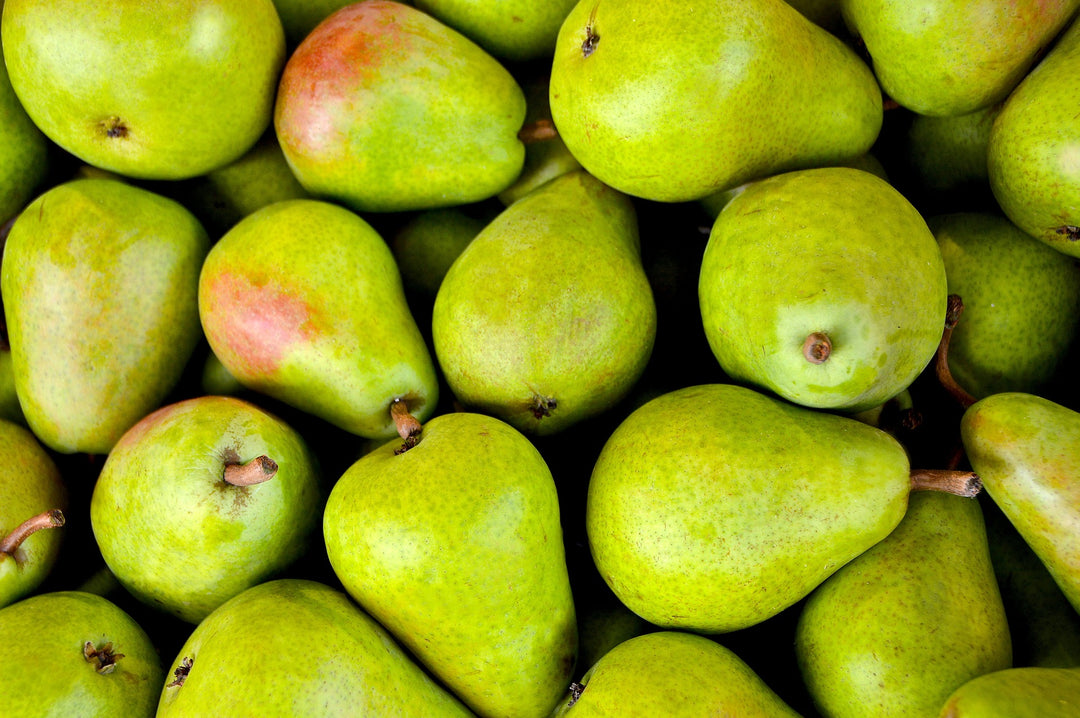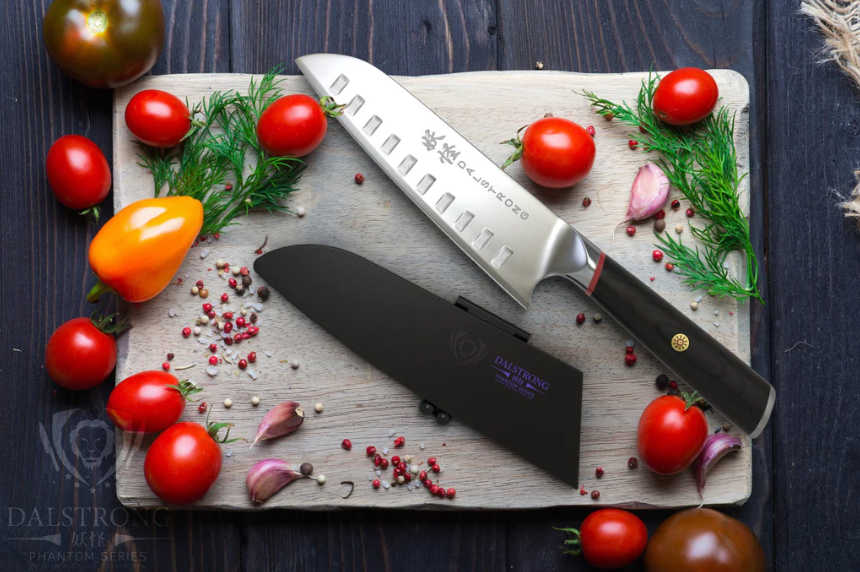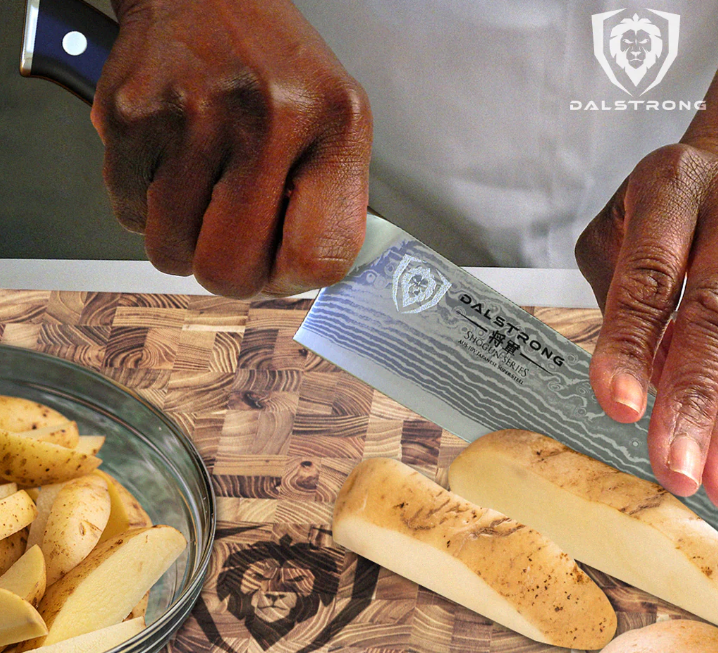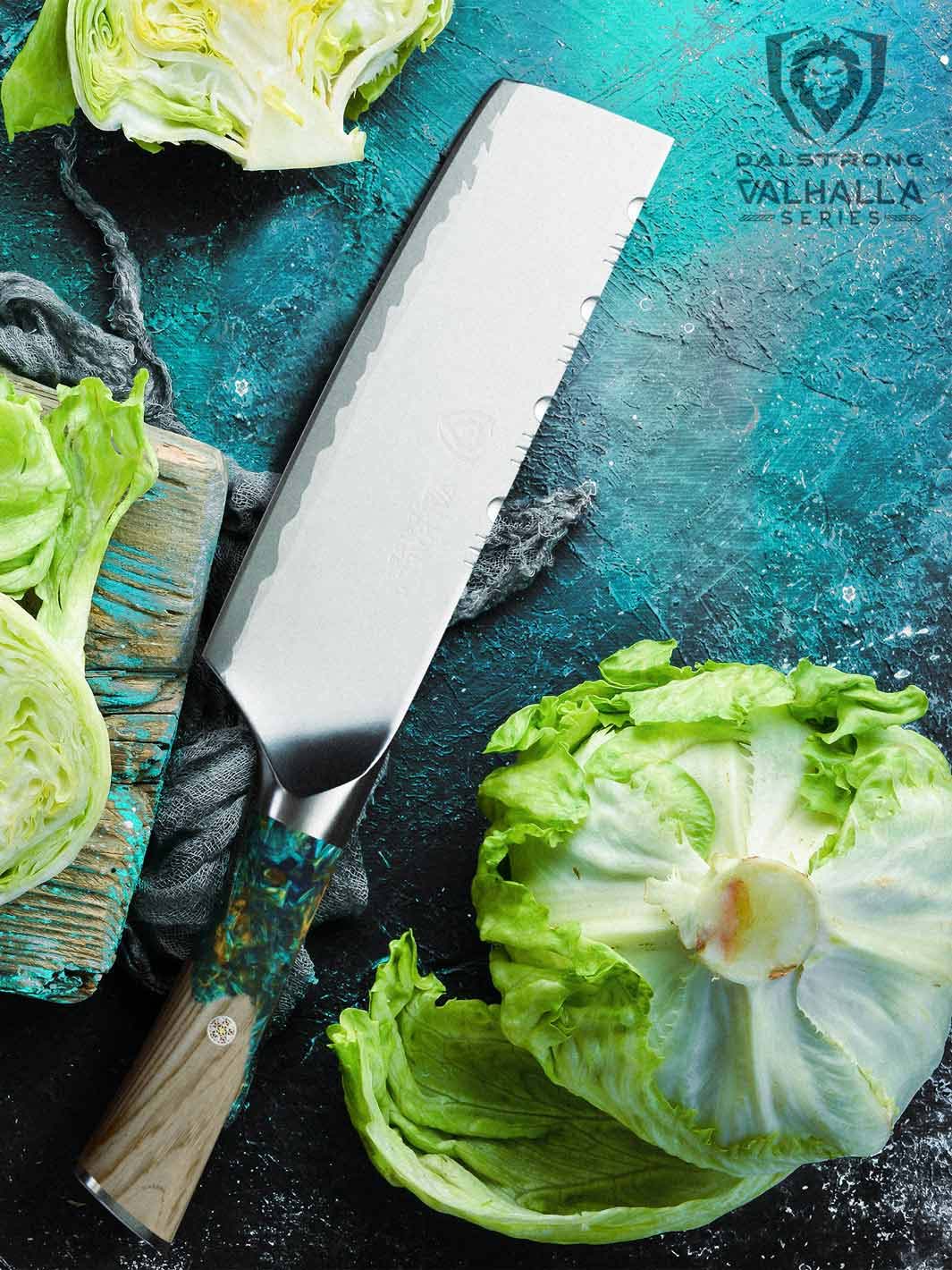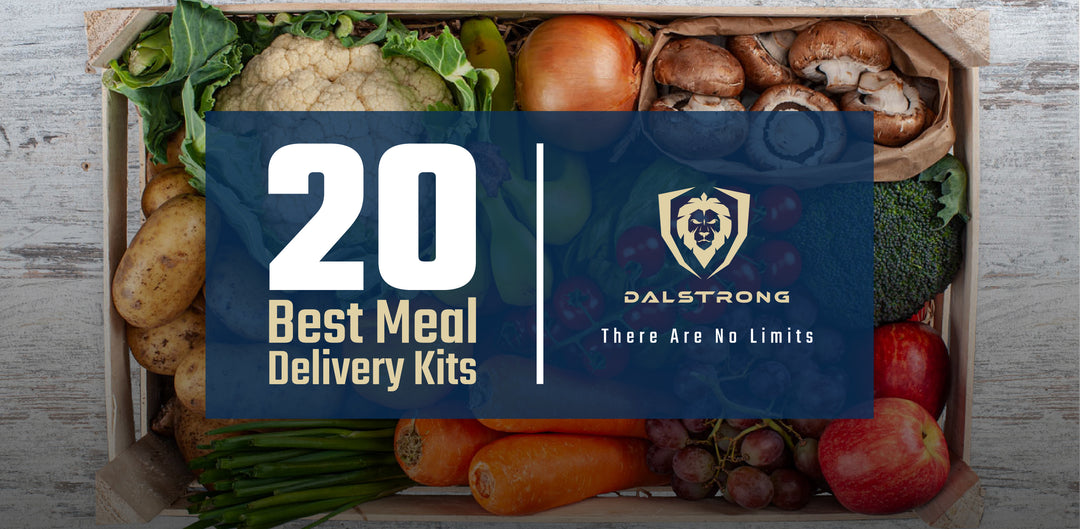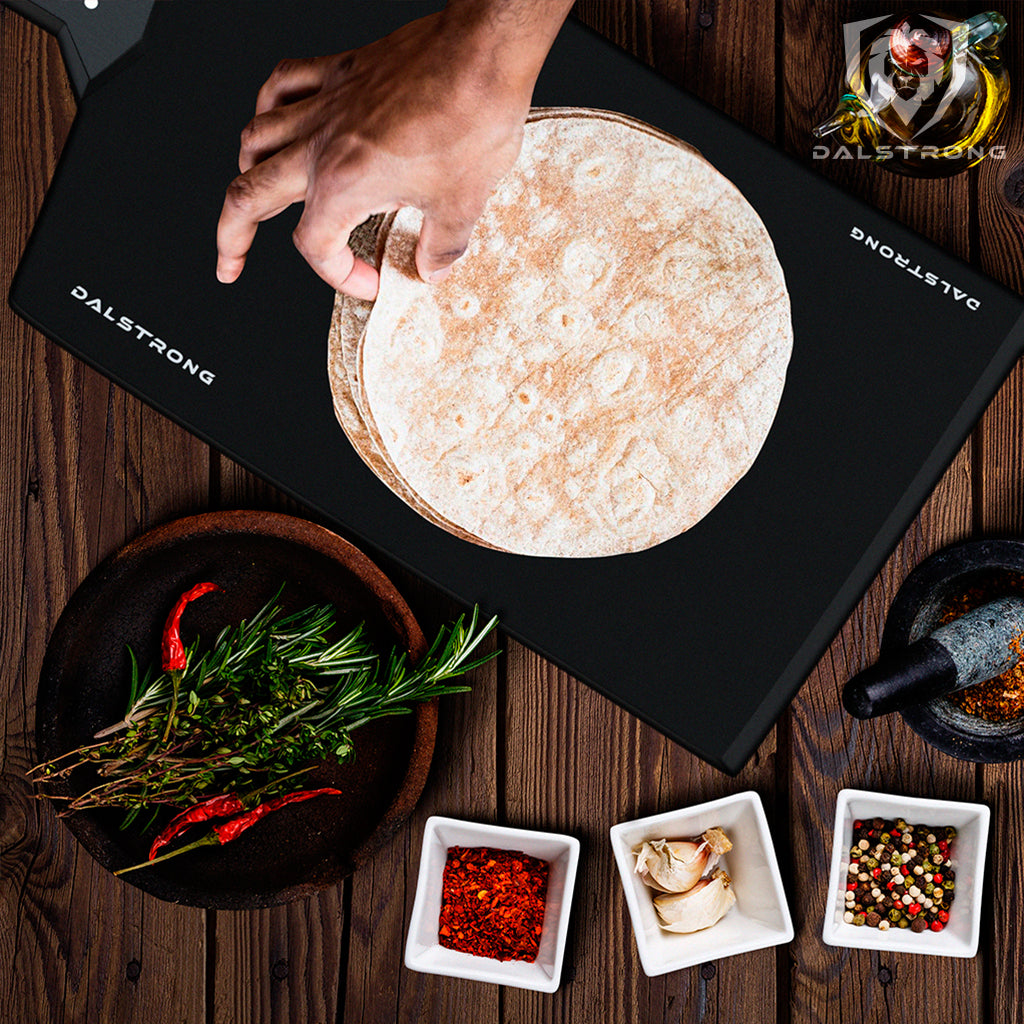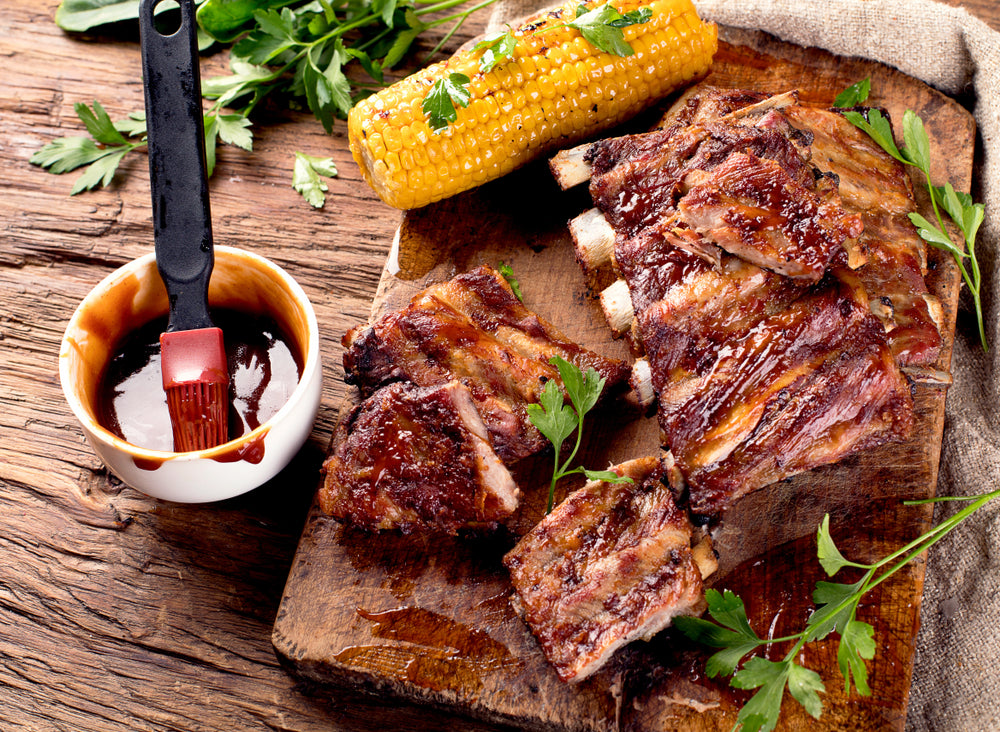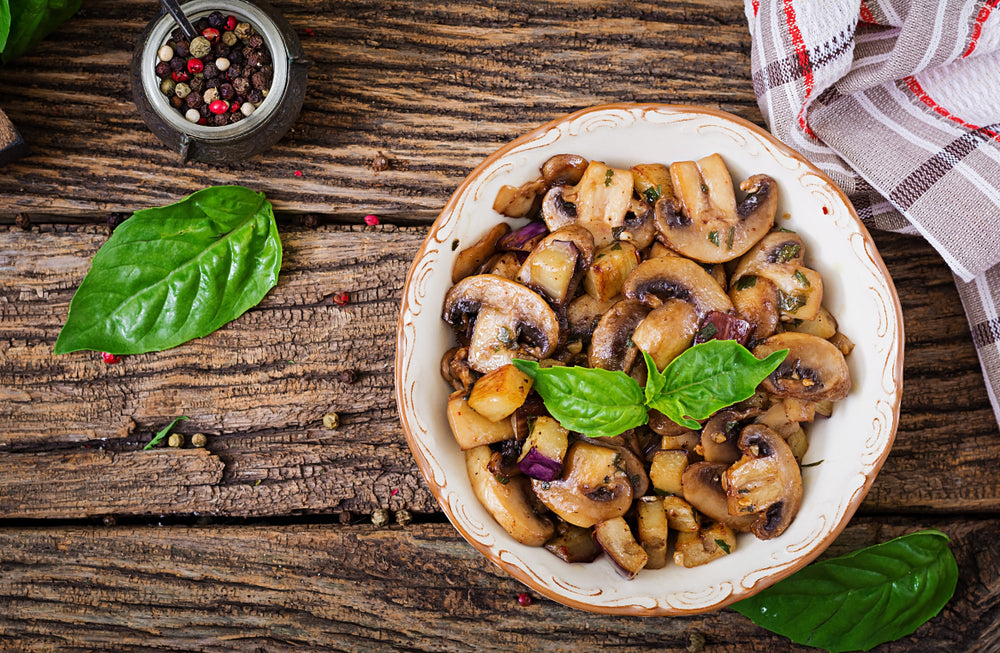Hot And Cold Soba Noodles Recipe
 10" Frying Pan & Skillet Silver | Oberon Series | Dalstrong ©
10" Frying Pan & Skillet Silver | Oberon Series | Dalstrong ©
Quick Overview: Soba Noodle Recipe
- Cook your soba noodles in a stockpot for a minute and a half, then transfer them to a bowl of ice water.
- Rinse the noodles under cold water to get rid of any stuck-on tapioca starch/dust.
- For the dipping sauce, mix salt, pepper, soy sauce, miso paste, toasted sesame oil, rice vinegar, maple syrup, fresh ginger, and one clove of garlic (grated) in a bowl.
- Slice green onions on your cutting board while the noodles and sauce are set aside.
- In a serving plate or bowl, mix the dipping sauce/dressing with the noodles and give it a fold with cooking tongs. Don’t toss, only fold. This will help keep the shape of the noodles intact.
- Garnish with a fried egg, bell peppers, baked tofu or crispy tofu, and some chopped green onions.
 Dalstrong Paring Knife 3.5" Shogun Series ELITE
Dalstrong Paring Knife 3.5" Shogun Series ELITE
Soba is a variety of buckwheat flour noodles that originated in the Middle Ages in Japan. The most unique part about this dish is that it is extremely versatile, as it can be served as a hot dish or just as cold soba noodles. Soba is quite literally food for the soul, as Buddhist monks would eat this before entering deep, zen-like meditations and fasts. If you're big on meal planning, this dish is going to come up trumps for you.
1. What Are Soba Noodles?
If you’re familiar with Korean BBQ, you’re probably aware that this dish is a famous side dish set aside with other appetizers for the main dish like crispy tofu, and noodle bowls, topped with a fried egg, and green onions.
However, in Japan, soba noodles are served as the main dish itself with some sesame oil. It is garnished with fresh ginger, shiitake mushrooms, and thinly sliced green onions or toasted sesame seeds. It is usually served with soup stew and other noodle salads.
2. How Are Soba Noodles Made?
This dish has a very nutty flavor in general as the dough is packed with miso paste, grated ginger, toasted sesame oil, part wheat flour, and part buckwheat flour. If you're looking for a weeknight dinner idea or simple brunch recipes with minimal prep time, this is the perfect one for you. The prep time for making soba noodles is 20-25 minutes. Here's how you would go about it!
Ingredients:
- Soba buckwheat flour
- All-purpose flour
- Filtered and chilled water
- Tapioca starch
- Set a large mixing bowl on a damp paper towel if you don't have a cutting board. This will hold the bowl in place as you make the dough from scratch.
- Using a sieve, sift all-purpose flour and buckwheat flour.
- In a small bowl, carefully measure and add 2 tablespoons of cold/chilled water, and set it aside.
- Add another cup of chilled water to the flour mixture and use your fingers to toss the mixture until it is evenly tossed and not stuck to the bottom of the bowl.
- After a minute of doing this, you should expect a crumbly mixture. Now, use your palms and push the dough in a circular dough until you see small clumps beginning to form.
- Gradually add water if the dough mix feels rough or dry to the touch.
- Transfer the dough to a flat and clean surface where you can work the semi-firm dough into a smooth consistency. Once you begin kneading the dough, reaching this consistency should take you no more than 4-5 minutes.
- Next, you want to transfer the ball of dough into a thick disk or a flat skillet.
- Dust your dough ball with some tapioca starch.
- Remove your dough and place it on a cutting board that is sprinkled with tapioca starch to prevent the dough from sticking.
- Cut the dough into four pieces.
Cooking Soba Noodles
- Time to get creative! Use a knife and a ruler to measure the thickness of your noodles. (1/8-inch-thick is ideal).
- Begin cutting your dough with a long knife.
- When the noodles are cut up, transfer them to a baking sheet and cover them with a plastic wrap.
- Refrigerate until you're ready to cook them.
- In a stock pot, add water and bring to a boil. Drop no more than 2 servings of the noodles into the water and cook for about a minute and a half. (Don't begin to stir).
- Keep a large bowl ready with ice water.
- Transfer the noodles into the bowl with ice water and set aside.
- Strain the noodles with a large mesh and run the noodles under chilled water.
You're all set to cook your very own batch of soba noodles! Did you know that chefs in Japan need to go through at least 3 years' worth of training to become soba masters?
3. How To Cook Soba Noodles to Perfection
Your book of recipe collections is incomplete unless you make a bowl of hot toasted sesame soba noodles. Here's our version of this incredible dish.
Hot Soba Noodles Recipe
Ingredients:
- Soba noodles
- Salt
- Black Pepper
- Sesame seeds
- Soy sauce
- Rice vinegar
- Maple syrup
- Miso paste
- Fresh ginger
- Grated garlic
- Green onions
Steps:
- Cook your soba noodles for 1-2 minutes in hot water, and transfer to a bowl with cold water.
- In a separate bowl, mix salt, pepper, soy sauce, toasted sesame oil, maple syrup, rice vinegar, miso paste, fresh ginger, and grated garlic.
- Chop thin slices of green onions. Feel free to use both white, and green parts of the vegetable.
- In a skillet, toss some sesame seeds and cover with a lid on low heat for 3-4 minutes.
- Garnish with green onions, fried egg, chopped bell pepper, baked tofu, and toasted sesame seeds.
- Fold the noodles with the sauce and serve the ultimate soba noodle bowl.
Cold Soba Noodles/Cold Soba Soup Stew
Are you looking to take it up a notch from a hearty bowl of chicken noodle soup? Then, read on.
Ingredients:
- Soba noodles
- Salt
- Black Pepper
- Low sodium chicken stock
- Miso paste
- Maple syrup
- Mirin
- Grated ginger
- Grated garlic
- Toasted sesame seeds
- Green Onion
Steps:
- In a large stock pot, add water and bring to a boil. Add salt, and pepper and cook the noodles until they're tender. (This should take you no more than 2-4 minutes for a recipe for a cold soba noodle bowl).
- Drain the hot water and transfer the cooked noodles to a bowl with cold water.
- In a separate bowl, add salt, pepper, soy sauce, mirin, maple syrup, grated ginger, grated garlic, toasted sesame seeds, and low sodium chicken stock.
- Garnish with more sesame seeds and one bunch of chopped-up green onions.
- And, voila! You're all set to devour buckwheat soba soup stew.
4. Nutritional Information
If you're looking for healthy lunch recipes or a quick weeknight dinner without compromising on the health benefits of food, sesame soba noodles make an excellent addition to your plate. Here's all the nutritional information you would need before cooking this recipe.
They're a great source of Magnesium
Soba noodles are full of magnesium to contribute to bone health. Buckwheat flour helps improve metabolism and also heal any wounds. The magnesium content in the flour helps your nervous system in the long run, too.
Buckwheat noodles are an excellent source of magnesium for treating diabetes, epilepsy, and osteoporosis. Soba noodles also include Zinc, Potassium, Phosphorous, Iron, and Thiamin.
Rich in Protein
Soba noodles contain 6 grams of protein per serving. This is crucial to maintaining, growing, and repairing cells in your body. The protein in toasted sesame seeds is excellent for building muscle, especially the heart muscles.
Helps Blood Sugar
Buckwheat is an incredible alternative to ordinary wheat flour as it has a lower GI response once you've finished your meal. So, foods made with buckwheat flour are great for decreasing insulin levels.
While it does have 24 grams of carbohydrates, it is still significantly less than what you'd find in traditional noodles and pasta. Since those noodles and pasta are rich in fiber, they slow down the process of digestion, which leads to a spike in levels of blood sugar.
Low in Fat
Not only do buckwheat noodles with sesame seeds taste great, but they're also low in sodium and fat. If you munch on them as baked snacks, they're fat-free. If you eat them as a single dish of cold soba noodles, you can add fresh herbs for a balanced meal.
Gluten-Free
Buckwheat flour is gluten-free. So, if you're looking for an easy dinner or a fast dinner that is equally delicious as traditional noodles and pasta, sesame soba noodles are a great alternative.
5. Dalstrong Tools You Will Need to Make Soba Noodles
Dalstrong is best known for its show-stopping and price-worthy knives and cookware. So, here is everything you would need for making a bowl of comfort food.
1. Food Tongs 12" Scalloped Silicone Tips
The silicone tips on this food tong make it super easy for you to fold in the sauce with your buckwheat noodles. Perfect for home cooks who will be cooking soba noodles for the first time. This 12” food tong is equipped to handle heavy cuts of meat and veggies, while also remaining delicate with noodles, pasta, and other soft foods.
Pros:
- This food tong is compatible with skillets, stockpots, and other cookware essentials.
- The length of this food tong helps keep your hands away from splatters of dipping sauce when mixing it with noodles.
Cons:
- If you are looking for shorter tongs, I would strongly suggest these. But rest assured, it isn’t going to cause you wrist fatigue when working with soba noodles.
- You could be looking for cooking tongs made entirely with stainless steel.
2. Lionswood Colossal Teak Cutting Board
This is one crucial piece of cookware to have handy when you’re working on the buckwheat flour dough. This cutting board is tough, sturdy, and can fit over a kitchen sink, which is perfect for a compact kitchen. Made with premium quality Teak Wood, this cutting board won’t disappoint you.
Pros:
- Resistant to bacteria and water.
- Infused with moisturizing oils for added durability.
- Doesn’t hold onto strong smells of miso paste, soy sauce, or mirin.
Cons:
- This cutting board has a higher price tag, but for all the right reasons.
- You may prefer a cutting board that is thinner in width. So, I suggest this cutting board.
3. 3 Quart Stock Pot Hammered Finish Black | Avalon Series
This 3-Quart stockpot is perfect for a small family or couple cooking toasted sesame seed soba noodles. This stock pot has a perfectly fitting stainless steel that helps in storing leftovers, dipping sauces for your noodles, and other sides. The 18/10 stainless steel design of this stock pot was created to last a lifetime. Resistant to dents, it is gas and induction cooktop friendly.
Pros:
- Equipped with a 5-Ply Copper Forged Foundation and a pot protector.
- This stockpot heats 5x and 20x quicker than its iron and stainless steel counterparts.
Cons:
- Some may prefer a different size of stock pot when choosing their cookware.
- It is used by professional chefs, which could be intimidating for home cooks. But, the size of this stock pot is not built to intimidate.
4. 12" Frying Pan & Skillet Hammered Finish Black | Avalon Series
This frying pan and skillet hybrid is the literal embodiment of function meeting form. This skillet has tremendous responsiveness to temperature change, which preserves the nutritional quality of your food, including the brown hue of buckwheat flour for your noodles. This is the perfect piece of cookware for flattening your dough and dusting the surface with tapioca starch evenly.
Pros:
- The nonstick rivets on the side boost the durability of your skillet.
- The size is perfect for home cooks and professional chefs.
Cons:
- The size, function, and appearance of this skillet put this on the higher end of the price range.
- Some may want individual pieces of cookware instead of hybrids.
5. Dalstrong Professional Chef's Kitchen Apron - American Legend
This apron is an asset to have, thanks to its lightweight and smooth design. It has an adjustable neck strap, a neck accent made out of genuine leather, as well as an easy-tie waist. It is highly durable and requires low maintenance. It can handle splashes of mirin and maple syrup, so don’t fret.
Pros:
- Made out of premium and genuine leather for added durability.
- This apron compliments industry-style décor in restaurants.
- It is equipped with adjustable straps and bountiful pocket space.
Cons:
- Its southern stylishness may not be up to the liking of all.
6. Chef & Cleaver Hybrid Knife 8" Crixus | Phantom Series
Looking for the perfect knife hybrid to chop up large cuts of meat, but also make thin slices of buckwheat Japanese noodles from scratch? Well, it only makes sense to use a Japanese knife for this exquisite Japanese recipe. The blade is forged with premium quality Japanese steel, too. The best part? The handle is made with Pakkawood imported directly from Spain, and this knife is low maintenance.
Pros:
- The price tag on this cleaver knife hybrid can fit into most budgets.
- Full-tang for added robustness.
- Stain-resistant.
Cons:
- If you’re looking for a Japanese knife dedicated only to slicing veggies and is a pro at cutting up the dough, I couldn’t recommend this Nakiri knife enough.
- Perhaps, you’re looking for a handle made entirely with stainless steel.
6. Frequently Asked Questions
What do you eat with soba noodles?
Soba noodles can be served in a low sodium broth or just as it is, tossed with maple syrup, rice vinegar, toasted sesame oil, and other condiments. It is best served with a fried egg and crispy tofu.
Are soba noodles the healthiest?
Soba noodles are the healthiest alternative you can find along with shitake noodles. Soba noodles are high in protein, low in fat, and gluten-free.
Why is soba so healthy?
Soba is healthy because it has low-fat content, and comparatively lower carb content, too. They’re gluten-free, which makes them an excellent alternative for individuals that can’t devour traditional noodles.
Does soba make you fat?
Soba has a significantly low-fat content, which makes it quite healthy compared to other noodles and pasta.































































































































































